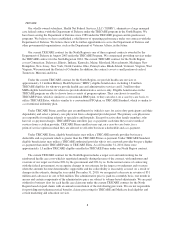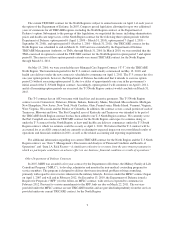Health Net 2010 Annual Report Download - page 19
Download and view the complete annual report
Please find page 19 of the 2010 Health Net annual report below. You can navigate through the pages in the report by either clicking on the pages listed below, or by using the keyword search tool below to find specific information within the annual report.awaiting further final guidance on a number of key topics such as rate review of unreasonable rates (a Notice of
Proposed Rulemaking was issued by HHS on December 21, 2010 with requirements for establishing a process
for review of “unreasonable” premium increases filed or effective on or after July 1, 2011), essential benefits, the
application of the health insurer fee, and federal criteria for participation in state-based exchanges, among others.
Though the federal government has issued interim final regulations, there remains considerable uncertainty
around the ultimate requirements of the legislation, as the interim final regulations are sometimes unclear or
incomplete, and are subject to further change. The federal government has also issued additional forms of
“guidance” that may not be consistent with the interim final regulations. As a result, many of the impacts of
health care reform will not be known for certain until the ultimate requirements of the legislation have been
definitively determined.
In addition to new federal regulations, various health insurance reform proposals are also emerging at the
state level. Many of the states in which we operate are expected to seek to implement parts of the federal health
care reform and even to add new requirements, such as prior approval of rates. Some states have passed
legislation or are considering proposals to establish an insurance exchange within the state to comply with
provisions of the health care reform legislation that become effective in 2014. For example, California recently
passed legislation establishing a state-based insurance exchange and authorizing an oversight board to negotiate
the price of plans sold on the insurance exchange. This could increase the pressure on us to contain our premium
prices and thereby could negatively impact our revenues and profitability. This legislation also could increase the
competition we face from companies that have lower health care or administrative costs than we do and therefore
can price their premiums at lower levels than we can. See “Item 1A. Risk Factors—We face competitive pressure
to contain premium prices.” California is the first state to adopt such a structure for a state-based insurance
exchange in response to the ACA. If other states in which we operate adopt a similar format for their exchanges,
that could further increase the competition that we face and the pressure on us to contain our premiums. At least
some states and possibly the federal government may condition health carrier participation in an exchange on a
number of factors, which could mean that some carriers would be excluded from participation. Even in cases
where state action is limited to implementing federal reforms, new or amended state laws will be required in
many cases. States also may disagree in their interpretations of the federal statute and regulations, and state
“guidance” that is issued could be unclear or untimely. The interaction of new federal regulations and the
implementation efforts of the various states in which we do business will create substantial uncertainty for us and
other health insurance companies about the requirements under which we must operate.
Adding to the uncertainty, there also have been Congressional and legal challenges to federal health care
reform that, if ultimately successful, could result in changes to the existing legislation or the repeal of ACA in its
entirety. In early 2011, a majority of the U.S. House of Representatives voted in favor of repealing the federal
health care reform legislation. A similar proposal was recently voted on by the U.S. Senate, but failed by a vote
of 47 to 51. Most of the bills proposed to repeal or replace certain provisions of ACA do not have bipartisan and
bicameral support, and are not expected to be signed into law by the current President. However, some recent
U.S. District Court cases have found that all or part of ACA is unconstitutional. For example, in December, 2010,
the U.S. District Court for the Eastern District of Virginia ruled that ACA’s mandate that U.S. citizens purchase
health insurance, or the individual mandate, is unconstitutional. In January 2011, the U.S. District Court for the
Northern District of Florida found the individual mandate provision unconstitutional and declared the entire
statute to be invalid. On the other hand, other U.S. District Courts have upheld the law. It is expected that the
constitutionality of the individual mandate and ACA itself will be ultimately decided by the U.S. Supreme Court.
Additionally, in California, the ongoing state budget deficits continue to threaten funding for the current
Medicaid program and Children’s Health Insurance Program, and the future expansion of these programs
authorized by federal health care reform is uncertain.
Due to the unsettled nature of these reforms and the numerous steps required to implement them, we cannot
predict how future regulations and laws, including state laws, implementing the new legislation will impact our
business. As a result, although we continue to evaluate the impacts of the new legislation, it could have a material
adverse effect on our business, financial condition and results of operations.
17
























